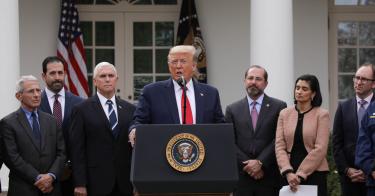President Trump’s declaration of a national emergency Friday to deal with the coronavirus pandemic is anything but a sign to panic. Instead, it’s a reassurance to the American people that the federal government, state and local governments, nongovernmental organizations and American industry are working together to stop the spread of the virus.
In many parts of our country, schools are shutting down for weeks. Businesses are sending their employees home to telework when possible. Churches and synagogues are closing their doors. Professional sports events have been canceled. More than 30 governors have declared states of emergency.
There are some who view this response to the coronavirus as an overreaction. After all, millions of Americans get the seasonal flu every year and we don’t take these measures.
But this isn’t an overreaction. On the contrary, this is a commonsense, measured response to mitigate the spread of the coronavirus.
In the Washington metropolitan area where I live, new cases of people testing positive for the coronavirus are being reported each day. Washington is an international city, with embassies housing foreign nationals from all over the world and people from other countries regularly visiting for business and vacation. Large conventions and conferences, along with packed sports arenas, are a daily occurrence in normal times.
That’s why it makes sense that this week, Washington and the surrounding states of Virginia and Maryland have all declared states of emergency. Maryland has banned gatherings of 250 people or more. In Washington and Virginia, mass gatherings have also been postponed or canceled.
Congress has shut down the Capitol and congressional offices to the public. Schools, colleges and universities are closing. Even major businesses like Capital One are asking employees to stay home and telecommute.
There are lessons to be learned from places like Italy, where currently the health care system is overwhelmed because the coronavirus is spreading faster than the system’s capacity to handle the influx of patients.
The facts are indisputable: social distancing is one of the primary ways to slow the trajectory of the spread of the coronavirus, reducing the number of active cases at any given time.
Slowing the trajectory spreads the cases out over time, giving hospitals and medical personnel the capacity to handle them. Slowing the trajectory also buys time for scientists to develop a vaccine and get more people vaccinated before they contract the disease.
Dr. Anthony Fauci, director of the National Institute of Allergy and Infectious Diseases, pointed out the need for social distancing when he told members of Congress that the number of cases will get worse – but how much worse will depend on our “ability to contain and mitigate within our own country.”
Some ask why these actions are being taken when we don’t take similar actions for the seasonal flu that strikes millions of Americans each year. The answer is that COVID-19—the disease caused by the coronavirus—appears to be deadlier and spread quicker.
Fauci and other health officials estimate that the COVID-19 death rate in the United States is likely somewhere around 1 percent. “The flu has a mortality rate of 0.1 percent. [COVID-19] has a mortality rate of 10 times that. That’s the reason I want to emphasize we have to stay ahead of the game in preventing this,” Fauci told members of Congress.
In addition to the higher death rate, the coronavirus appears to be more infectious than the flu. With the seasonal flu, a single infected person will infect another 1.3 people. According to the Journal of the American Medical Association, early estimates point to a single person with the coronavirus infecting another two to three people.
Based on those numbers—the potential for more than double the infection rate and 10 times the death rate of the flu—the coronavirus could result in a horrific number of deaths in the United States this year if mitigation efforts aren’t introduced immediately.
Rather than an overreaction, social distancing and these other measures are prudent. And rather than instilling fear, they should bring some sense of relief to the American people. Because positive measures are being taken, less people may become infected, and we’re working toward ensuring that the American health care system has the capacity to handle new cases.
Mitigation measures like postponing conferences and conventions, canceling sporting events, and having employees work from home may bring a temporary but painful disruption to the economy. But that’s a relatively small price to pay to save the lives of many people in our country.
We would do well to heed the advice the British government offered a fearful nation under much worse circumstances during World War II: “Keep calm and carry on.”
Today carrying on means following the advice of the president and our nation’s leading health care professionals. It means living our lives while at the same time practicing responsible social interaction. That’s not panicking. That’s doing your civic duty to help protect yourself, your family, and your fellow Americans.
Originally published by Fox News




